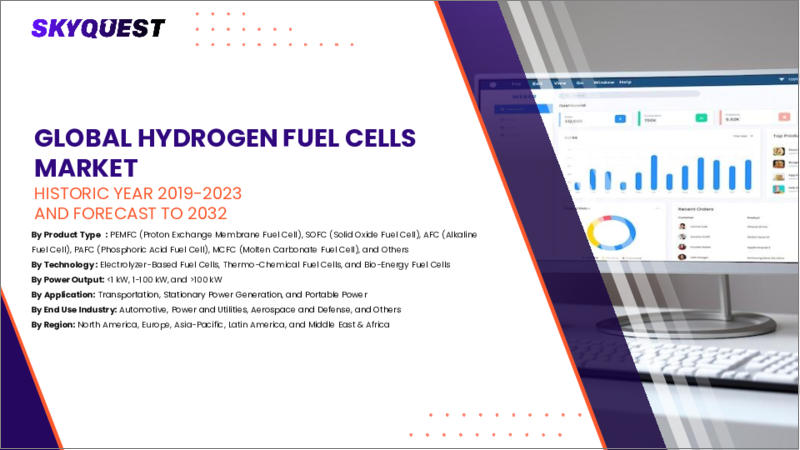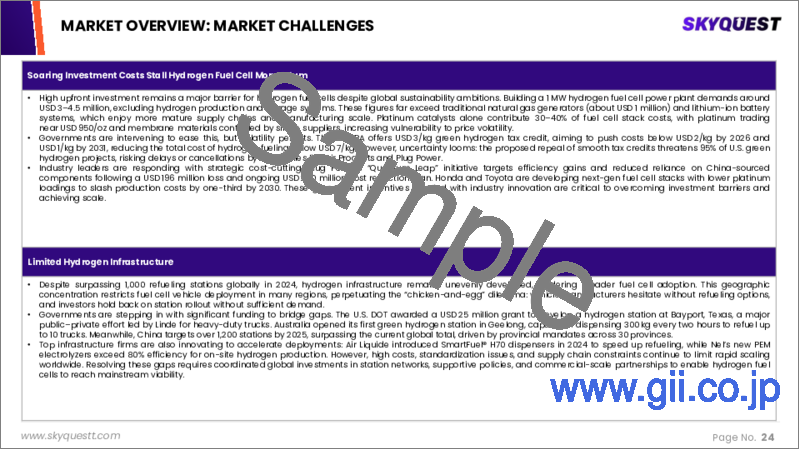|
|
市場調査レポート
商品コード
1663135
水素燃料電池の市場規模、シェア、成長分析:タイプ別、用途別、エンドユーザー別、地域別 - 産業予測 2025~2032年Hydrogen Fuel Cells Market Size, Share, and Growth Analysis, By Type (Proton Exchange Membrane Fuel cells, Phosphoric Acid Fuel Cells), By Application (Stationary, Transport), By End-user, By Region - Industry Forecast 2025-2032 |
||||||
|
|||||||
| 水素燃料電池の市場規模、シェア、成長分析:タイプ別、用途別、エンドユーザー別、地域別 - 産業予測 2025~2032年 |
|
出版日: 2025年02月19日
発行: SkyQuest
ページ情報: 英文 198 Pages
納期: 3~5営業日
|
全表示
- 概要
- 目次
水素燃料電池市場規模は2023年に32億9,000万米ドルと評価され、2024年の41億1,000万米ドルから2032年には245億米ドルに成長し、予測期間(2025-2032年)のCAGRは25%で成長する見通しです。
世界の水素燃料電池市場は、クリーンで持続可能なエネルギーソリューションに対する需要の高まりによって大きな成長を遂げています。EUが2030年までに40GWの水素電解容量を目標に掲げていることや、日本や韓国でも同様の取り組みが行われていることがその例です。しかし、燃料電池技術の高コストや、水素貯蔵・流通のための不十分なインフラといった課題が、市場導入の妨げになる可能性もあります。とはいえ、この進化する情勢は、企業にとってエネルギー、輸送、製造などの部門を横断する革新と協力の十分な機会を提供し、水素燃料電池技術の有望な可能性を利用する好機となっています。
目次
イントロダクション
- 調査の目的
- 調査範囲
- 定義
調査手法
- 情報調達
- 二次と一次データの方法
- 市場規模予測
- 市場の前提条件と制限
エグゼクティブサマリー
- 世界市場の見通し
- 供給と需要の動向分析
- セグメント別機会分析
市場力学と見通し
- 市場概要
- 市場規模
- 市場力学
- 促進要因と機会
- 抑制要因と課題
- ポーターの分析
主な市場の考察
- 重要成功要因
- 競合の程度
- 主な投資機会
- 市場エコシステム
- 市場の魅力指数(2024年)
- PESTEL分析
- マクロ経済指標
- バリューチェーン分析
- 価格分析
水素燃料電池市場規模:タイプ別& CAGR(2025-2032)
- 市場概要
- プロトン交換膜燃料電池
- リン酸燃料電池
- 固体酸化物燃料電池
- 溶融炭酸塩燃料電池
- その他
水素燃料電池市場規模:用途別& CAGR(2025-2032)
- 市場概要
- 据置型
- 輸送機関
- 携帯型
水素燃料電池市場規模:エンドユーザー別& CAGR(2025-2032)
- 市場概要
- 燃料電池自動車
- ユーティリティ
- 防衛
水素燃料電池市場規模:地域別& CAGR(2025-2032)
- 北米
- 米国
- カナダ
- 欧州
- ドイツ
- スペイン
- フランス
- 英国
- イタリア
- その他欧州地域
- アジア太平洋地域
- 中国
- インド
- 日本
- 韓国
- その他アジア太平洋地域
- ラテンアメリカ
- ブラジル
- その他ラテンアメリカ地域
- 中東・アフリカ
- GCC諸国
- 南アフリカ
- その他中東・アフリカ
競合情報
- 上位5社の比較
- 主要企業の市場ポジショニング(2024年)
- 主な市場企業が採用した戦略
- 最近の市場動向
- 企業の市場シェア分析(2024年)
- 主要企業の企業プロファイル
- 企業の詳細
- 製品ポートフォリオ分析
- 企業のセグメント別シェア分析
- 収益の前年比比較(2022-2024)
主要企業プロファイル
- Plug Power(United States)
- Ballard Power Systems(Canada)
- Bloom Energy Corporation(United States)
- FuelCell Energy(United States)
- Nel ASA(Norway)
- Ceres Power Holdings(United Kingdom)
- ITM Power PLC(United Kingdom)
- PowerCell Sweden AB(Sweden)
- Doosan Fuel Cell(South Korea)
- McPhy Energy SA(France)
- Hydrogenics(Canada)
- AFC Energy PLC(United Kingdom)
- Hexagon Composites ASA(Norway)
- SFC Energy AG(Germany)
- ElringKlinger AG(Germany)
- Cummins Inc.(United States)
- Air Products and Chemicals, Inc.(United States)
- Siemens Energy(Germany)
結論と提言
Hydrogen Fuel Cells Market size was valued at USD 3.29 Billion in 2023 and is poised to grow from USD 4.11 Billion in 2024 to USD 24.5 Billion by 2032, growing at a CAGR of 25% during the forecast period (2025-2032).
The global hydrogen fuel cells market is witnessing substantial growth driven by the escalating demand for clean and sustainable energy solutions. With significant investments from governments and corporations worldwide, the sector is poised for expansion, exemplified by the EU's goal of 40GW hydrogen electrolysis capacity by 2030 and similar initiatives in Japan and South Korea. However, challenges such as the high costs of fuel cell technology and the insufficient infrastructure for hydrogen storage and distribution could hinder market adoption. Nevertheless, this evolving landscape presents ample opportunities for companies to innovate and collaborate across sectors like energy, transportation, and manufacturing, making it an opportune time to tap into the promising potential of hydrogen fuel cell technologies.
Top-down and bottom-up approaches were used to estimate and validate the size of the Hydrogen Fuel Cells market and to estimate the size of various other dependent submarkets. The research methodology used to estimate the market size includes the following details: The key players in the market were identified through secondary research, and their market shares in the respective regions were determined through primary and secondary research. This entire procedure includes the study of the annual and financial reports of the top market players and extensive interviews for key insights from industry leaders such as CEOs, VPs, directors, and marketing executives. All percentage shares split, and breakdowns were determined using secondary sources and verified through Primary sources. All possible parameters that affect the markets covered in this research study have been accounted for, viewed in extensive detail, verified through primary research, and analyzed to get the final quantitative and qualitative data.
Hydrogen Fuel Cells Market Segments Analysis
Global Hydrogen Fuel Cells Market is segmented by type, application, end-user and region. Based on type, the market can be segmented into Proton Exchange Membrane Fuel cells, Phosphoric Acid Fuel Cells, Solid Oxide Fuel Cells, Molten Carbonate Fuel Cells, and Others. Based on application, the market is segmented into Stationary, Transportation, and Portable. Based on end-user, the market is segmented into Fuel Cell Vehicles, Utilities, and Defense. Based on region, the market is segmented into North America, Europe, Asia Pacific, Middle East and Africa, and Latin America.
Driver of the Hydrogen Fuel Cells Market
The increasing concern over climate change and air pollution has heightened the demand for sustainable and efficient energy alternatives to fossil fuels. Hydrogen fuel cells present a viable solution, delivering clean and efficient power while significantly lowering carbon emissions and enhancing air quality. Unlike conventional combustion engines, fuel cells generate electricity through the reaction of hydrogen and oxygen, resulting in water and heat as the only byproducts. This technology finds versatility across various sectors, including transportation, industry, and residential applications, making it a crucial driver in the transition toward a more sustainable energy landscape.
Restraints in the Hydrogen Fuel Cells Market
While the global hydrogen fuel cells market has shown notable progress over the years, it still faces significant constraints due to its higher costs compared to conventional combustion technologies. The elevated expenses stem from the expensive materials required, such as platinum and other rare metals that serve as catalysts in the electrochemical reactions producing electricity. Additionally, the intricate manufacturing process necessitates specialized equipment and facilities, further inflating costs. Consequently, the financial barrier posed by hydrogen fuel cells hinders the broader acceptance of fuel cell vehicles, which remain pricier than traditional gasoline-powered options, limiting their accessibility to a wider consumer base.
Market Trends of the Hydrogen Fuel Cells Market
The Hydrogen Fuel Cells market is witnessing significant growth, driven by escalating ecological concerns and the urgent need to transition away from non-conventional energy sources. While the shorter lifespan of these fuel cells poses challenges, the compelling advantages of generating emission-free energy are propelling market expansion. Substantial investments in green energy initiatives further enhance the market landscape. The increasing adoption of hydrogen fuel cells in heating and power generation within both residential and commercial applications is also aiding sales momentum. Additionally, supportive reforms in energy policies from various associations and governments align with the rising demand for reliable power solutions, ensuring a favorable environment for market growth.
Table of Contents
Introduction
- Objectives of the Study
- Scope of the Report
- Definitions
Research Methodology
- Information Procurement
- Secondary & Primary Data Methods
- Market Size Estimation
- Market Assumptions & Limitations
Executive Summary
- Global Market Outlook
- Supply & Demand Trend Analysis
- Segmental Opportunity Analysis
Market Dynamics & Outlook
- Market Overview
- Market Size
- Market Dynamics
- Drivers & Opportunities
- Restraints & Challenges
- Porters Analysis
- Competitive rivalry
- Threat of substitute
- Bargaining power of buyers
- Threat of new entrants
- Bargaining power of suppliers
Key Market Insights
- Key Success Factors
- Degree of Competition
- Top Investment Pockets
- Market Ecosystem
- Market Attractiveness Index, 2024
- PESTEL Analysis
- Macro-Economic Indicators
- Value Chain Analysis
- Pricing Analysis
Global Hydrogen Fuel Cells Market Size by Type & CAGR (2025-2032)
- Market Overview
- Proton Exchange Membrane Fuel cells
- Phosphoric Acid Fuel Cells
- Solid Oxide Fuel Cells
- Molten Carbonate Fuel Cells
- Others
Global Hydrogen Fuel Cells Market Size by Application & CAGR (2025-2032)
- Market Overview
- Stationary
- Transportation
- Portable
Global Hydrogen Fuel Cells Market Size by End User & CAGR (2025-2032)
- Market Overview
- Fuel Cell Vehicles
- Utilities
- Defense
Global Hydrogen Fuel Cells Market Size & CAGR (2025-2032)
- North America (Type, Application, End User)
- US
- Canada
- Europe (Type, Application, End User)
- Germany
- Spain
- France
- UK
- Italy
- Rest of Europe
- Asia Pacific (Type, Application, End User)
- China
- India
- Japan
- South Korea
- Rest of Asia-Pacific
- Latin America (Type, Application, End User)
- Brazil
- Rest of Latin America
- Middle East & Africa (Type, Application, End User)
- GCC Countries
- South Africa
- Rest of Middle East & Africa
Competitive Intelligence
- Top 5 Player Comparison
- Market Positioning of Key Players, 2024
- Strategies Adopted by Key Market Players
- Recent Developments in the Market
- Company Market Share Analysis, 2024
- Company Profiles of All Key Players
- Company Details
- Product Portfolio Analysis
- Company's Segmental Share Analysis
- Revenue Y-O-Y Comparison (2022-2024)
Key Company Profiles
- Plug Power (United States)
- Company Overview
- Business Segment Overview
- Financial Updates
- Key Developments
- Ballard Power Systems (Canada)
- Company Overview
- Business Segment Overview
- Financial Updates
- Key Developments
- Bloom Energy Corporation (United States)
- Company Overview
- Business Segment Overview
- Financial Updates
- Key Developments
- FuelCell Energy (United States)
- Company Overview
- Business Segment Overview
- Financial Updates
- Key Developments
- Nel ASA (Norway)
- Company Overview
- Business Segment Overview
- Financial Updates
- Key Developments
- Ceres Power Holdings (United Kingdom)
- Company Overview
- Business Segment Overview
- Financial Updates
- Key Developments
- ITM Power PLC (United Kingdom)
- Company Overview
- Business Segment Overview
- Financial Updates
- Key Developments
- PowerCell Sweden AB (Sweden)
- Company Overview
- Business Segment Overview
- Financial Updates
- Key Developments
- Doosan Fuel Cell (South Korea)
- Company Overview
- Business Segment Overview
- Financial Updates
- Key Developments
- McPhy Energy SA (France)
- Company Overview
- Business Segment Overview
- Financial Updates
- Key Developments
- Hydrogenics (Canada)
- Company Overview
- Business Segment Overview
- Financial Updates
- Key Developments
- AFC Energy PLC (United Kingdom)
- Company Overview
- Business Segment Overview
- Financial Updates
- Key Developments
- Hexagon Composites ASA (Norway)
- Company Overview
- Business Segment Overview
- Financial Updates
- Key Developments
- SFC Energy AG (Germany)
- Company Overview
- Business Segment Overview
- Financial Updates
- Key Developments
- ElringKlinger AG (Germany)
- Company Overview
- Business Segment Overview
- Financial Updates
- Key Developments
- Cummins Inc. (United States)
- Company Overview
- Business Segment Overview
- Financial Updates
- Key Developments
- Air Products and Chemicals, Inc. (United States)
- Company Overview
- Business Segment Overview
- Financial Updates
- Key Developments
- Siemens Energy (Germany)
- Company Overview
- Business Segment Overview
- Financial Updates
- Key Developments





